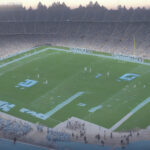Key Technology Trends Highlighted at ECOC 2025
The 51st European Conference on Optical Communications (ECOC 2025) took place in Copenhagen from September 28 to October 2, attracting over 2,000 delegates from more than 70 countries and featuring over 500 presentations. The conference offered a comprehensive platform for discussions and showcases centered on advancements in optical communications technology. Nokia, a leading innovator in networking technology, played a prominent role by contributing two workshops, more than 30 papers and presentations, four posters, and commemorating the century-long legacy of Bell Labs with a special event.
Alongside the technical conference, the ECOC exhibition ran from September 30 through October 1, drawing approximately 6,000 visitors and 350 exhibitors. Nokia’s booth displayed a range of its latest innovations, including the Nokia 1830 GX hyperscale optical line system (OLS), thin transponders featuring ICE-X 800ZR/ZR+ pluggable modules, coherent routing technology using C+L ICE-X 800G pluggables compatible with Nokia and other vendors’ routers, and cutting-edge advances such as ICE-X 400G coherent breakout (4x100G), ICE-D technology for intra-datacenter optics, optical fiber sensing combined with anomaly detection, optical spectrum as a service, and closed-loop energy optimization solutions.
After attending the full conference and exhibition activities, several key technology trends emerged across the optical communications landscape:
Advancements in Higher Baud Rates
Conference sessions reviewed the trajectory and challenges of increasing baud rates in coherent optical pluggables. The industry is actively developing 250+ GBaud pluggables (1600ZR/ZR+) anticipated to reach the market around 2027–2028. A critical question is whether baud rates can be doubled to reach 500 GBaud enabling single wavelength 3.2 terabit (T) pluggables, and the timeline for such advancement. A key technological constraint involves the analog-to-digital and digital-to-analog converters (ADC/DAC) inside digital ASICs or DSPs, which are limited by the cutoff frequency (f_T) achievable with current CMOS processes. To achieve 500 GBaud, CMOS processes would require an f_T near 1,000 GHz, forecasted to be available only around 2035. To bridge this gap, researchers including Di Che from Nokia Bell Labs presented concepts involving ADC/DAC (de-)multiplexing, which leverages higher frequency semiconductors like indium phosphide or silicon germanium on separate chips. While offering potential performance benefits, these approaches bring higher costs and power consumption, limiting their feasibility in pluggable modules. Consequently, 3.2T coherent pluggables are expected initially to be dual wavelength before progressing to single wavelength formats as CMOS technology advances. Looking further ahead, 1,000 GBaud rates may emerge after 2040, potentially enabled by novel modulators such as plasmonic devices combined with advanced multiplexing techniques.
Modulator Technology Innovations
Modulator bandwidth remains a bottleneck for silicon photonics. Indium phosphide continues to be the only mature material with proven volume production and reliability capable of supporting the next generation of coherent optical signals above 250 GBaud. However, thin film lithium niobate (TFLN) is rapidly maturing both as a technology and ecosystem, bolstered by the emergence of new foundries showcased at ECOC 2025. Nokia Bell Labs highlighted extensive experimentation with TFLN modulators, exploring their potential for high baud rate compatibility.
Emerging materials like thin film lithium tantalate (TFLT) also attracted interest due to potential advantages such as higher power handling capabilities. Another trend involves silicon photonics micro-ring modulators, which offer benefits of significantly smaller size and reduced power consumption compared to traditional Mach-Zehnder modulators, albeit with lower bandwidth. Notably, NVIDIA announced their use of micro-ring modulators in recently unveiled coherent pluggable optics (CPO) products, signaling growing industry adoption. Plasmonic modulators, while promising exceptional speed and miniaturization, remain largely experimental within academic and startup research arenas.
Coherent Pluggable Optics Developments
Coherent pluggable modules were a focal point at the conference. Nokia representatives including Rob Shore, Fady Masoud, and Julia Larikova delivered presentations emphasizing wide-ranging applications and technological aspects. Rob and Fady centered their sessions on 800ZR and 800ZR+ applications featuring thin transponders, while Julia showcased component and packaging innovations underpinning Nokia’s ICE-X 800G pluggables.
An important highlight was the exhibition of multi-vendor interoperability of 800ZR/ZR+ pluggables in the Optical Internetworking Forum’s (OIF) demonstration area, underscoring the maturation of standards and ecosystem collaboration. A notable application discussed was “scale across”—utilizing 800ZR/ZR+ pluggables to interconnect multiple metropolitan datacenters for AI training workloads. Meta’s Jeff Rahn presented insights on their deployment strategy for 800ZR/ZR+ modules directly in routers, emphasizing the need for interoperability, backward compatibility, and sharing operational data from a 600 Gb/s mode over a 1,200 km route from Portland to Sacramento.
Presentations also addressed future 1600ZR, 1600ZR+, and 1600CL pluggables with anticipated commercial availability in the 2027 to 2028 timeframe. Discussions included whether 3.2T pluggables would initially use dual wavelengths due to power consumption and the cooling requirements (potentially liquid cooling) associated with higher performance modules. Additionally, non-coherent quantum key distribution (QKD) QSFP28 pluggables were introduced, hinting at future directions for integrating quantum-safe encryption technologies in optical networks.
Multi-Rail Optical Networking
As coherent optical engines near theoretical capacity limits defined by Shannon’s law, network designers are increasingly adopting multi-rail approaches to scale capacity. This entails deploying multiple parallel fiber pairs between network nodes. However, this expansion creates operational complexities especially at in-line amplifier (ILA) huts responsible for amplifying optical signals between terminals, add-drop multiplexers, or reconfigurable optical add-drop multiplexer (ROADM) nodes.
Current ILA racks typically have power budgets limited to about 3 kilowatts per rack, with a usual maximum of four racks. Accommodating ILAs for many parallel fiber pairs drives innovations in amplifier designs, pump lasers, optical channel monitors (OCMs), dynamic gain equalizers (DGEs), and optical time-domain reflectometers (OTDRs). OEMs including Nokia and component manufacturers are responding by developing smaller, more efficient lasers often featuring multi-emitter packages and uncooled operation modes. Efforts to reduce cost, size, and power involve sharing devices such as OCMs, DGEs, and OTDRs across more rails, enabling an increase in the number of ILAs per rack unit from around 1 today to potentially 8, 16, or higher.
Progress in Hollow Core Fiber (HCF) Technology
Hollow core fiber, a specialty optical fiber with markedly lower latency and scattering than traditional solid glass fibers, continues to see improved performance. Leading companies YOFC and Linfiber reported reductions in fiber attenuation down to approximately 0.05 dB/km. Microsoft showcased experimental results of long-distance transmissions traversing over 11,400 km at 25.6 Tb/s and shorter distances of nearly 2,900 km at 20.6 Tb/s through HCF loops.
A key observation was the growing maturity of the HCF ecosystem. Besides Microsoft’s advances, collaborations involving YOFC, which partnered with Nokia for two papers last conference, and OFS, active in 2024 HCF trials with Nokia, were notable. Coherent notably surprised attendees by exhibiting a spool of HCF slated for sampling in 2026. Microsoft revealed partnerships with industry leaders Corning and Heraeus aimed at scaling HCF manufacturing, highlighting a growing commercial focus. Amazon Web Services (AWS) also contributed to the discourse, showcasing interest in HCF applications.
ECOC 2025 underscored the dynamic evolution of optical communications technologies critical to supporting future digital transformation demands. From pushing the boundaries of baud rates and modulation to scaling coherent pluggables for AI workloads and innovating in fiber infrastructure, industry leaders including Nokia, Bell Labs, Meta, Microsoft, and others are collectively advancing toward next-generation high-capacity, energy-efficient, and resilient optical networks. The event reaffirmed Europe’s position as a hub for optical innovation and the collaborative spirit driving the industry forward.










